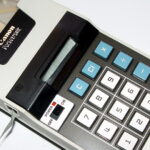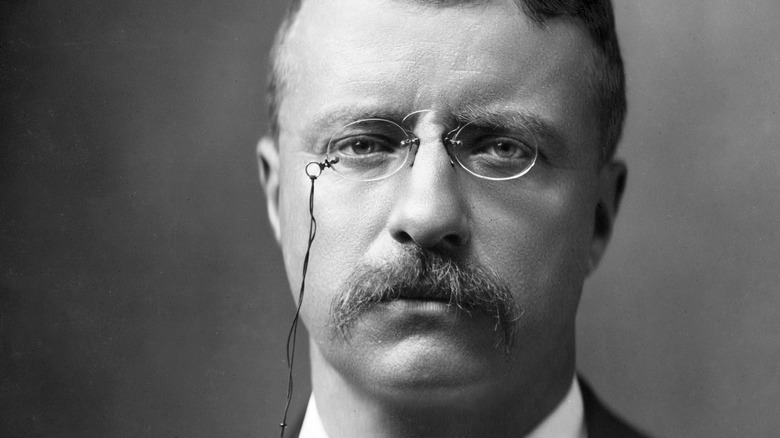
The Truth About The Invention Of The First Handheld Calculator
Seeing as up to 70% of web traffic is mobile phones (via TechJury), there’s a better-than average chance you’re literally reading this article on a pocket computing device right now. Sure, you probably use said device mainly for arguing with strangers and looking at cat pictures, but at its core, it’s just a math machine. There’s nothing stopping you from flipping over to the calculator app right now to find out what the square root of 20,857,489 is (it’s 4,567).
Considering how advanced pocket computers are these days, it’s hard to believe that just a few decades ago, most people were still adding on their fingers. To be sure, there were things like the abacus (which dates back to ancient times) or the slide rule (mid-19th century), but they required some user expertise, and they couldn’t really be carried around in your pocket. An electronic device that could do math, let alone one that was handheld, was out of reach to most until the mid-20th century. But it happened, thanks to the people at Texas Instruments.
These days, we tend to take miniaturization of electronics for granted, but early in the 20th century, several factors were preventing it from happening — mainly vacuum tubes. Complex electrical devices like radios required circuits that would send very specific currents in very specific directions, and early on, the vacuum tube, which was more or less a tiny, not very bright light bulb, was the only way to accomplish this. Vacuum tubes were bulky, and, being made of glass, not particularly durable. This is the main reason that early radios and televisions were essentially home appliances — cumbersome things with big, permanent living room footprints that required frequent repair.
How electric devices were miniaturized: the transistor
All of this changed, though, with the introduction of the transistor. The transistor, which began to find its way into consumer electronics in the late 1950s, replaced the vacuum tube’s glass bulb with a chunk of silicon, resulting in so-called “solid-state” circuits that were smaller, lighter, and more durable, along with drawing less power. The Sony TR-63, the first commercially successful “transistor radio,” hit the market in 1957 and forever changed the way people listened to music (via Radio Museum). No longer was a radio just a thing in your living room; it was now a thing in your pocket that you could listen to anywhere. While the transistor radio was a certified hit, though, it would take yet another invention before the pocket calculator could happen.
Even as transistor radios took the world by storm, computing devices remained stubbornly bulky. All that math just required too many complex circuits, even with transistors at the disposal of their designers. By 1954, IBM had built the first all-transistor calculator: the IBM 608, built with germanium transistors instead of silicon. It was the size and shape of several refrigerators rubber-banded together, and it would set you back more than $83,000 (via EdTech). By 1961, British company Bell Tech had introduced a desktop calculator about the size of a typewriter, which ran on 180 tiny vacuum tubes and a single transistor and cost only $1000 (via Vintage Calculators). It would be another six years before anyone solved the “pocket calculator” problem.
The story of the Texas Instruments 'Cal Tech' calculator
In the mid-1960s, Texas Instruments president Pat Haggerty looked at the transistor radio and asked himself, “Why can’t we do that again?” If the calculator could be miniaturized and made affordable, he could market it not just to power users, but everyday users as well. And TI already had the missing piece: the integrated circuit. The now-ubiquitous integrated circuit (IC) is an entire electric circuit, including transistors and everything else, “printed” onto a single silicon chip. TI was already selling large quantities of ICs to industry and the military, but Haggerty saw an opportunity to expand into consumer devices.
To head up the team, he recruited the inventor of the IC himself, future Nobel laureate Jack Kilby, whose team finally put together a device codenamed the “Cal Tech.” It measured an almost-pocket-sized 4.25″ x 6.15″ x 1.75″ and weighed just under three pounds (via Vintage Calculators). Its “display” was actually a roll of thermal paper that it would print inputs and outputs on. And they fit all of its components onto a mere four silicon chips (via Smithsonian).
While the original Cal Tech device never made it to market, much of the technology was licensed to Canon, who in 1971 introduced the Pocketronic, which sold for a few hundred dollars (via Vintage Calculators). And the rest, as they say, is history … though in this case, that history somehow ends with you hiding in the bathroom, playing “Angry Birds.”

The Truth About Robin Williams And Pam Dawber's Relationship

What You Don't Know About Hitler's Dog Blondi

The Psychology Behind The Jonestown Massacre Finally Explained

The History Of The Drawing And Quartering Death Penalty

Why Geoff Nicholls Left Black Sabbath

How Google Earth Helped Solve The Case Of A Brutal Execution

Here's What Would Happen If The Hoover Dam Broke

Bizarre Things That Don't Make Sense About Rasputin's Death

What The Deadliest Avalanche In US History Was Really Like

The Tragic Death Of James Taylor's Older Brother

























